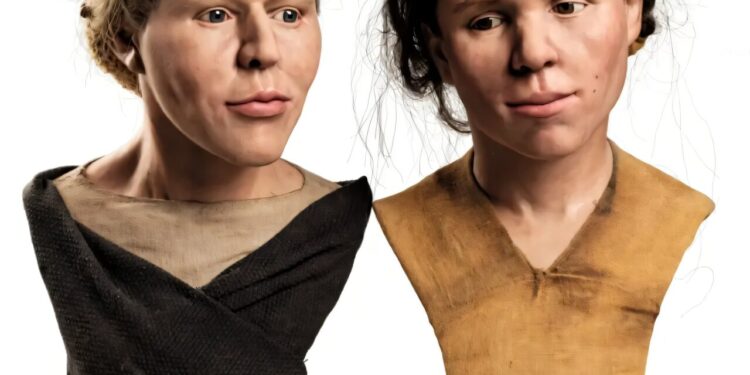Anthropological reconstruction of H2A females – left and H1 – right. Credit: F. Fojtík in Vaníčková et al. 2025
Almost three decades ago, the Cherlet mining area in the Krumlov forest was discovered. Since then, many things have been written on the mining activity that took place here. Although the CHART exploitation occurred here from the start of the Holocene to the early iron age, it was not a particularly widespread activity.
For the most part, it has been limited to a few selected archaeological cultures, including Funnelbeker, Michelsbergs, Globular Amphorae and Mierzanowice cultures.
Among the sites on which these mining activities took place, some included buried people, such as the Mauer burial in Vienna, Austria.
“The mining was carried out here from wide trees up to a depth of 8 m, then horizontally in the slope with counter-sponsors (zone VI), from wells largely lowered with counter-deputies on a flat floor (in zone I), and probably also small tunnels on the slope …” explained Dr Vaníčková.
With the burials of Mauer, the burials discovered on the Krumlov forest site are the oldest European tombs we know.
To understand the complete history of these buried individuals of the Krumlov forest site, Dr. Eva Vaníčková and his colleagues carried out an in -depth analysis, in particular the determination of age, sex, health, food consumption, relationships of kinship and geographic origin.
The study is published in the journal Archaeological and anthropological sciences.
In total, three buried people were recovered: two adults and a newborn baby. The remains were appointed H1 / 2002, H2A / 2002 and H2B / 2002.
The two adults were both women. Based on morphological and thaponomic analyzes, they were between 30 and 35 (H1 / 2002) and 35 and 40 (H2A / 2002).
Skull of Female H2A Enface (A) and the female skull H1 Enface (B) Credit: F. Fojtík in Vaníčková et al. 2025
Their bones have provided evidence that these two women had carried out extreme physical work during their lives, including various changes in their vertebrae, including the growth of osteophytes (bone spur), schmorl nodes (disk prophesions), hyperkyphosis (abnormal curvature of the spine) and the erosion of vertebrae.
The degenerative vertebral signs, as well as evidence of marked muscle attachments, suggest that these women have probably worked in advanced positions, perhaps as minors in narrow underground trees.
According to their isotopic signatures, we know that they were local and received a surprisingly high proportion of animal proteins in their diet compared to other Neolithic populations in the Czech Republic. These women have received greater diets based on animal protein to help them maintain better physical condition while exploiting CHERT.
On the other hand, proof of an Ulna fracture, which has never been authorized to heal, indicates that women were forced to continue working even when they are injured.
It is possible that these women, instead of men, were forced to work in the mines due to the rise in the social role of men in the Eneolithic. The hardest work may no longer have been done by the strongest, but by those who could do it most easily to do so. Perhaps these women are proof of this growing theory.
According to DNA evidence, we know that the two women were linked, perhaps to the brothers and sisters. As a child, they experienced a significant period of stress, reflected in Harris lines on their teeth and the hypoplasia of the linear enamel on the teeth of H2A. The exact cause of their death is unknown.
Meanwhile, the newborn is more enigmatic. The newborn died around 38 to 40 weeks and, according to DNA evidence, was not linked to one or the other of women, five of its alleles differing from those of H1 and H2A.
The reason for the burial of the newborn with the two women is unknown. However, the reason for women’s burial in the tree can be clearer.
Dr. Vaníčková and his colleagues explain: “The practical value of the mined fashion was minimal, because it could be collected on the surface. However, it is questionable if the people associated the stone of the depths of the earth with an ancestral heritage, which means that its value was subjective.”
CHERT was generally used to create prestigious objects such as axes, long blades and daggers. These were often placed later in ritual deposits. Thus, the extraction of CHERT extends beyond practical needs and may have been influenced by social and cultural factors.
The exploitation of CHERT may have been considered a sacred work, possibly linking the living with the underground world of the ancestors.
As the two women were directly associated with the mining work, it may have been considered to be necessary to return the work of minors, including in some cases the minors themselves, back on earth.
Many questions remain, especially if women were working voluntarily in mines or have been forced to do so.
Written for you by our author Sandee Oster, edited by Sadie Harley, and verified and revised by Robert Egan – This article is the result of meticulous human work. We are counting on readers like you to keep independent scientific journalism alive. If this report matters to you, please consider a donation (especially monthly). You will get a without advertising count as a thank you.
More information:
Eva Vaníčková et al, ritual burials in a prehistoric mining tree in the forest of Krumlov (Cychy), Archaeological and anthropological sciences (2025). DOI: 10.1007 / S12520-025-02251-1
© 2025 Science X Network
Quote: Prehistoric minors identified using a multidisciplinary approach (2025, August 19) recovered on August 20, 2025 from
This document is subject to copyright. In addition to any fair program for private or research purposes, no part can be reproduced without written authorization. The content is provided only for information purposes.



